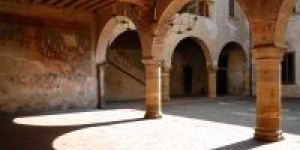Malpaga Castle was built by a Ghibelline before the advent of gun power. Thanks to the deep moat surrounding it, the Castle was unassailable over a long time: it came back to life in 1456, when the famous Captain General of the Venice Republic Bartolomeo Colleoni decided to buy Malpaga’s Borough for 100 gold ducats, aiming to turn it into his private house and the centre of his domain.
The Castle thus became the Commander’s headquarter and witnessed numerous outstanding historic events, hosting renowned figures paying homage to the Captain, such as Borso d’Este, Francesco Sforza’s sons, Charles II Duke of Burgundy and Christian I king of Denmark.
Malpaga Castle is one of the most outstanding XIV Century Lombard buildings. It overlooks 330 hectares of farmlands in the Park of River Serio, creating an amazing natural and architectural complex leading the territorial requalification project called PER MALPAGA.
Every weekend from March to November, Malpaga Castle opens its gates and displays all its treasures. During these exclusive tours you can admire the beautiful frescos decorating the ancient Halls, carried out by renowned artist between the XV and the XVII Century: you can experience the charm of the past as you walk through the door of the castle, decorated with furniture reproducing the style of that period.
Moreover, it is also possible to visit the hamlet of Malpaga upon request, with a lovely tour by carriage all around the Castle, to discover the its most secret places. Lots of events, initiatives and historic re-enactments, such as the traditional Palio of Malpaga, enliven the Hamlet and take the Castle back to life throughout the year.
Malpaga Castle was built by a Ghibelline before the advent of gun power. Thanks to the deep moat surrounding it, the Castle was unassailable over a long time: it came back to life in 1456, when the famous Captain General of the Venice Republic Bartolomeo Colleoni decided to buy Malpaga’s Borough for 100 gold ducats, aiming to turn it into his private house and the centre of his domain.
The Castle thus became the Commander’s headquarter and witnessed numerous outstanding historic events, hosting renowned figures paying homage to the Captain, such as Borso d’Este, Francesco Sforza’s sons, Charles II Duke of Burgundy and Christian I king of Denmark.
Malpaga Castle is one of the most outstanding XIV Century Lombard buildings. It overlooks 330 hectares of farmlands in the Park of River Serio, creating an amazing natural and architectural complex leading the territorial requalification project called PER MALPAGA.
Every weekend from March to November, Malpaga Castle opens its gates and displays all its treasures. During these exclusive tours you can admire the beautiful frescos decorating the ancient Halls, carried out by renowned artist between the XV and the XVII Century: you can experience the charm of the past as you walk through the door of the castle, decorated with furniture reproducing the style of that period.
Moreover, it is also possible to visit the hamlet of Malpaga upon request, with a lovely tour by carriage all around the Castle, to discover the its most secret places. Lots of events, initiatives and historic re-enactments, such as the traditional Palio of Malpaga, enliven the Hamlet and take the Castle back to life throughout the year.

Dressing of all participants in period costumes, to fully immerge in the Courtly life. The guided visit continues across the halls of the Castle, decorated with antique furniture and rich of precious frescos painted by renowned artists of XV, XVI and XVII Century.
The tour ends with a medieval group dance.
Duration: 2 hours and a half
At least 25 participants
Dressing of all participants in period costumes, to fully immerge in the Courtly life. The guided visit continues across the halls of the Castle, decorated with antique furniture and rich of precious frescos painted by renowned artists of XV, XVI and XVII Century.
The tour ends with a medieval group dance.
Duration: 2 hours and a half
At least 25 participants